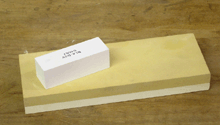|
|
04/16/2009 A look at this peripheral aide to sharpeng with waterstones. |
 I was talking to my friend Ron Hock and the subject of nagura stones came up. What are they for? How do they work? Do they contaminate anything? Do you need one? Since I get these questions all the time it made sense to turn the answers into a blog entry. I was talking to my friend Ron Hock and the subject of nagura stones came up. What are they for? How do they work? Do they contaminate anything? Do you need one? Since I get these questions all the time it made sense to turn the answers into a blog entry.
A Nagura stone is a small waterstone, the word "nagura" means "correcting" in Japanese. The stone is used to condition waterstones during use. For natural waterstones their use is to wear away hard particles or contamination in the waterstone, and to selectively allow flattening by being rubbed on a high spots on the stone. Another usage is to create slurry.
With artificial waterstones, which are far more common these days, there is of course no contamination that needs to be removed and most people use flattening plates of some sort to keep their stones flat. If you use a diamond stone for flattening and you just let the stone dry with the slurry from flattening on it and you have lots of slurry. In that sense the nagura is obsolete.
However most sharpening leaves a hollow in a waterstone and selectively rubbing the ends of a stone with a nagura can keep the stone flatter longer. In a addition you get a slurry.
Toshio Odate in his classic book Japanese Woodworking Tools says (along with tons of other useful info) that if, on a hard finishing stone, your tool slips rather than abrades on the stone, creating a little slurry will stop the slippage. Odate also taught me that the single biggest mistake his students make when sharpening is not working the finishing stones long enough. After his instruction I began working my final stone longer than I thought I needed to and this got me better results. At the same time letting the water on the finishing stone dry out as I worked the tool with the slurry lets the abrasive in the slurry break down and you have an effectively finer abrasive surface. Some people say that as the slurry contains steel particles, keeping the slurry leads to scratches and the slurry should not be used. I don't follow this school of thought and I think I am in the majority.
However the main thought here is that for faster honing clean sharp abrasive is better. For final polishing slurry is better. So adding slurry using a nagura before you start sharpening on a particular grit makes little sense to me especially on coarser grits. On harder finer stones (finishing stones that mimic natural stones for one) starting on a clean stone makes sense to me, then as you work the stone, using a nagura on the ends to even out wear and create more slurry, which you let dry, also makes logical sense although if the stone is softer so that a good slurry develops anyway, why bother with the nagura?
In general I don't use a nagura stone these days, except to remove high spots on the stone when I am in the middle of working.
The follow-up question I get about naguras is: how come the nagura doesn't contaminate the finer stone? Some people think it does. I don't see any evidence that is does because the way that the nagura works is that it must be harder than the binder used to hold a stone together but considerably softer than a the actual abrasive of the waterstone, with a tough binder. So rubbing the nagura on the stone, wears away binder and releases sharp abrasive, and the sharp abrasive, coupled with pressure from the steel on the stone, shatters the larger, softer particles of nagura that get on the stone. And that makes the contamination vanish harmlessly into the slurry. |
Join the conversation |
|
 Joel's Blog
Joel's Blog Built-It Blog
Built-It Blog Video Roundup
Video Roundup Classes & Events
Classes & Events Work Magazine
Work Magazine



best regard and keep the info and good service.
David Gendron
Yukon, Canada
Thanks for this post.I agree with essentially everything but would like to add another idea.
Taking this a step further, what about some crushing/shattering of the waterstone's abrasive particles? I posted on this topic here:
http://www.rpwoodwork.com/blog/2008/12/09/enhancing-the-action-of-finishing-stones/
This describes the use of the Atoma 1200 as a "nagura" (though that does change the definition of the word) to enhance the action of very fine stones. The particles of the stone are crushed, a slurry is raised, and some on-the-fly flattening occurs as well.
On the basis of shop results, I think it works and also gives a nice feel of the steel on the stone.
Rob